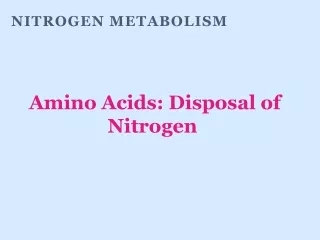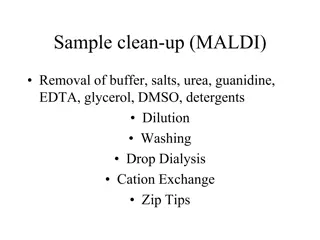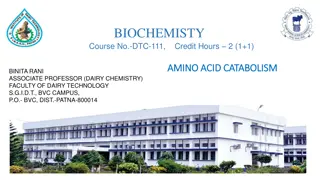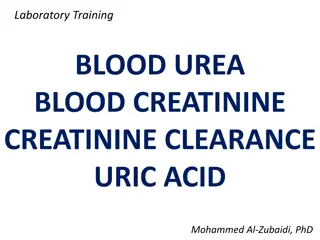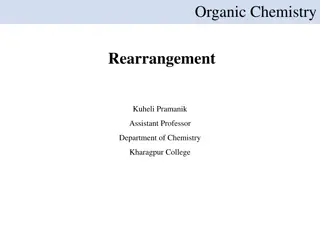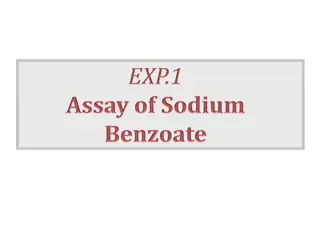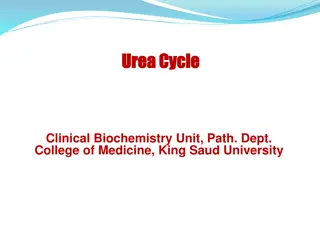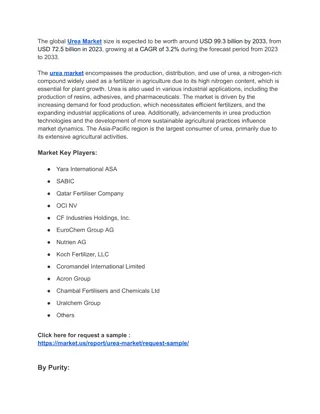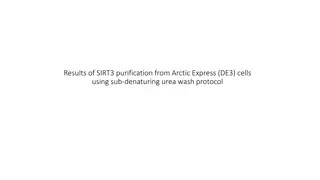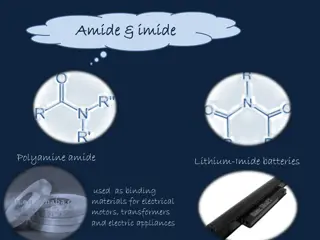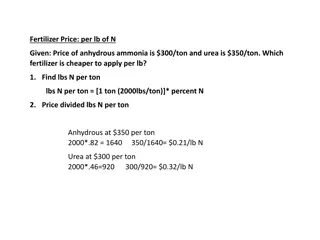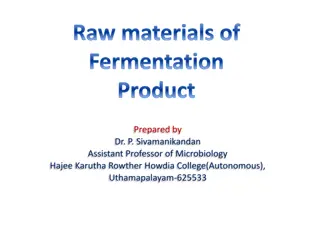Amino Acids: Disposal of Nitrogen
Overview of nitrogen metabolism with a focus on the disposal of nitrogen through amino acid catabolism. It explains the process of removing the α-amino groups from amino acids, the synthesis of urea, and the conversion of carbon skeletons to energy-producing pathways.
36 views • 65 slides
Kidney Function Tests
The physiological functions of the kidney, the structure of the nephron, and the importance of kidney function tests. Discover the routine tests used, including serum creatinine, creatinine clearance, and serum urea, and how they can confirm diagnoses, determine disease severity, and monitor treatme
5 views • 23 slides
Electrolyte and Metabolic Disturbances in the Critically Ill
Dr. Srilekha Ammapalli discusses the cations (sodium, potassium, calcium, magnesium) and anions (chloride, bicarbonate, phosphate, lactate) involved in electrolyte and metabolic disturbances in critically ill patients. The physiology, causes of abnormalities, diagnosis, evaluation, and management of
2 views • 104 slides
Issues related to Fertilizers
The Department of Fertilizers discussed key issues related to fertilizers at the Kharif Conference 2023, focusing on promoting alternate fertilizers like nano urea and nano DAP, as well as initiatives such as PM Kisan Samrudhi Kendras and One Nation One Fertilizer. Detailed figures were presented on
0 views • 22 slides
Laboratory Training
Kidneys play a vital role in the body by filtering waste and maintaining fluid balance. Learn about the structure of kidneys, nephron function, and the importance of blood urea and serum creatinine tests in assessing kidney health. Discover how factors like protein intake and medical conditions affe
1 views • 44 slides
Understanding Barbiturates: History, Types, and Mechanism of Action
Barbiturates are derivatives of barbituric acid, acting as depressants on the central nervous system by potentiating GABA. First synthesized in 1864, they have a rich history in medicine. Types include Amobarbital, Phenobarbital, and Pentobarbital. The synthesis of barbituric acid involves a condens
0 views • 28 slides
Choosing the Best Humectant for Skin Hydration
This helps protect the skin from environmental stressors and irritants. Among the popular humectants are hyaluronic acid, glycerin, urea, and panthenol, each offering unique benefits for skin hydration and health.
3 views • 3 slides
Protein Sample Clean-Up Methods for MALDI Analysis
Protein sample clean-up for MALDI involves removing various contaminants like buffer, salts, urea, guanidine, EDTA, glycerol, DMSO, and detergents through methods such as dilution, washing, drop dialysis, cation exchange, and solid phase extraction using Zip tips. The process aims to reduce interfer
0 views • 8 slides
Urea Biosynthesis and the Krebs-Henseleit Cycle in the Liver
Urea is synthesized in the liver through a series of enzymatic steps known as the urea cycle or Krebs-Henseleit cycle. This process involves converting toxic ammonia into urea, a less toxic and water-soluble compound that can be easily excreted in urine. The liver plays a crucial role in urea biosyn
1 views • 20 slides
Understanding Renal Function Tests and Kidney Health
Renal function tests are essential for diagnosing and monitoring kidney health. These tests assess functions like glomerular filtration, tubular reabsorption, and endocrine functions of the kidneys. Common indicators include serum urea, creatinine levels, and more. It's crucial to evaluate renal fun
0 views • 34 slides
Amino Acid Catabolism: Pathways and Reactions
Amino acid catabolism involves removing amino groups via deamination, leading to urea synthesis and TCA cycle intermediates. The process includes transamination and oxidative deamination reactions, with specific aminotransferases catalyzing these reactions. Transamination is a key step in funneling
0 views • 23 slides
Understanding Nitrogen Metabolism: Amino Acid Biosynthesis and Ammonia Incorporation
Nitrogen metabolism is crucial in the biosynthesis of amino acids such as glutamate and glutamine, incorporating ammonia for various physiological processes. Ammonia is efficiently transported and stored using compounds like alanine and glutamate, playing a key role in the urea cycle. Glutamate, a v
0 views • 22 slides
Understanding Kidney Function and Laboratory Tests
This article delves into the structure and function of the kidneys, specifically focusing on nephrons and the implications of nephron loss. It also discusses the importance of blood urea and serum creatinine tests in evaluating kidney function, highlighting the differences between the two and their
2 views • 44 slides
Intravenous Anaesthetics and Barbiturates: Usage, Advantages, and Disadvantages
Intravenous anaesthetics, including barbiturates and non-barbiturates, offer advantages such as easy induction and smooth recovery but come with drawbacks like lack of control over anaesthesia level and contraindications in certain conditions. Barbiturates, derived from melonyl urea, are classified
1 views • 24 slides
Understanding the Urea Cycle in Biochemistry
Explore the intricate process of the urea cycle, its role in removing amino groups from amino acids, converting ammonia into urea in the liver, and managing hyperammonemia. Learn about transamination, oxidative deamination, and the importance of glutamine and alanine in ammonia transport. Discover t
1 views • 26 slides
Overview of Organic Chemistry Rearrangement Reactions
Explore different rearrangement reactions in organic chemistry such as Curtius rearrangement, Lossen rearrangement, and Schmidt rearrangement. Understand the mechanisms, applications, and examples of these reactions in synthesizing various compounds like isocyanates, amines, and urea derivatives.
0 views • 19 slides
Understanding Protein Digestion and Amino Acid Metabolism
The process of protein digestion involves proteolytic enzymes produced by the stomach, pancreas, and small intestine. Pepsinogen is activated to pepsin in the stomach, breaking down proteins into oligopeptides and amino acids. After absorption, amino acids are utilized for protein synthesis and as d
0 views • 7 slides
Sodium Benzoate: Properties, Applications, and Pharmaceutical Uses
Sodium benzoate is a white crystalline powder with various physical and chemical properties. It is commonly used as a preservative in pharmaceutical formulations, cough preparations, and cosmetic products. Additionally, it has pharmaceutical applications in treating urea cycle disorders and schizoph
0 views • 9 slides
Urea Cycle: An Overview of Ammonia Detoxification and Urea Formation
Understand the intricate process of ammonia detoxification through the urea cycle, where amino groups from amino acids are converted to urea for disposal. Learn about the importance of transamination reactions, blood transport of ammonia to the liver, and causes and management of hyperammonemia. Exp
0 views • 26 slides
Understanding Inborn Errors of Metabolism and Metabolic Disorders
Inborn Errors of Metabolism (IEM) are genetic disorders that disrupt metabolic pathways, leading to substrate accumulation or product deficiency. These disorders can be classified based on toxic accumulation, protein metabolism, carbohydrate intolerance, lysosomal storage issues, energy production d
0 views • 29 slides
Understanding Nonelectrolytes in Solutions
Physical properties of substances are classified into colligative, additive, and constitutive properties. Colligative properties depend on the number of particles in a solution and are similar for different nonelectrolytes. Additive properties are based on the total contribution of atoms, while cons
1 views • 14 slides
Urea Market
The global Urea Market size is expected to be worth around USD 99.3 billion by 2033, from USD 72.5 billion in 2023, growing at a CAGR of 3.2% during the forecast period from 2023 to 2033.\nClick here for request a sample : \/\/market.us\/report\/urea
1 views • 4 slides
Understanding Urolithiasis: Causes, Diagnosis, and Management
Urolithiasis, commonly known as kidney stones, has evolved over the years with changes in patterns and risk factors. This condition can affect different parts of the urinary tract and is influenced by factors like dietary deficiencies, urinary solute imbalances, and inadequate drainage. Various type
1 views • 58 slides
Results of SIRT3 Purification from Arctic Express Cells using Urea Wash Protocol
The purification protocol for SIRT3 from Arctic Express cells involved a series of steps utilizing urea washes to remove Cpn60. Two urea wash runs showed effective removal of Cpn60, with greater efficacy observed with 2M urea compared to 1M urea. The gel results indicated successful elimination of C
1 views • 5 slides
Livestock Skillathon Feedstuff Identification Challenge
Test your knowledge of feedstuff identification with this livestock skillathon challenge. Identify various feedstuffs such as alfalfa meal, cottonseed meal, urea, and more from provided images. Check your answers against the solutions to see how well you did!
0 views • 8 slides
Managing Farmland Nitrogen Emissions: Strategies and Research Updates
Soils play a crucial role in greenhouse gas emissions and carbon sequestration. Karl Richards, Head of Soils, Environment & Land-Use Department at Teagasc, discusses the importance of managing farmland nitrogen emissions through various practices. Research focuses on reducing emissions and enhancing
0 views • 8 slides
Comparative Analysis of Amide, Imide, and Urea Compounds in Chemical Testing
This analysis delves into the properties and chemical reactions of amide, imide, urea, and related compounds like sulphanilamide and phthalimide. It explores their characteristics such as odor, solubility, and reactions to different tests like acid-base testing and preliminary examinations. The disc
0 views • 10 slides
Fertilizer Application and Cost Analysis for Soil Nutrients
This detailed agricultural analysis discusses the cost-effectiveness of applying anhydrous ammonia versus urea based on nitrogen content per pound, provides recommendations for nitrogen rates based on yield goals and soil analysis, calculates pounds of nutrients and fillers in a fertilizer blend, an
0 views • 7 slides
Raw Materials in Industrial Fermentation Processes
Microorganisms utilized in industrial fermentation require essential raw materials such as water, energy sources, carbon, nitrogen, mineral elements, and sometimes vitamins and oxygen. Various raw materials like cane molasses, beet molasses, cereal grains, starch, glucose, and lactose serve as carbo
0 views • 15 slides
Overview of the Urinary System: Functions, Structure, and Importance
The urinary system plays a crucial role in maintaining water and salt balance, regulating pH levels, and excreting waste products like urea and uric acid. Comprising of organs such as the kidneys, ureters, urinary bladder, and urethra, this system ensures the removal of metabolic waste from the body
0 views • 34 slides
Understanding Compartmental Model of a Dialysis Machine in Biomedical Engineering
Explore the compartmental models of a dialysis machine in the field of Biomedical Engineering, focusing on one- and two-compartmental models of haemodialysis. Learn how mathematical modeling aids in tailoring dialysis therapy to individual patient needs, and discover the different approaches to dial
0 views • 14 slides
Understanding the Role of Carbamide Cream in Dermatology
Carbamide cream, commonly known as urea cream, is a versatile skincare product widely used in dermatology to treat a variety of skin conditions. This cream is valued for its hydrating and exfoliating properties, making it a staple in skincare routine
0 views • 5 slides
Foot Care Cream For Dry & Rough Heels in India
Foot care cream with shea butter, coffee, and urea is a nourishing treatment that helps rejuvenate dry, rough feet. Shea butter deeply moisturizes and softens the skin, while coffee helps improve circulation and provides a natural exfoliating effect,
2 views • 4 slides
